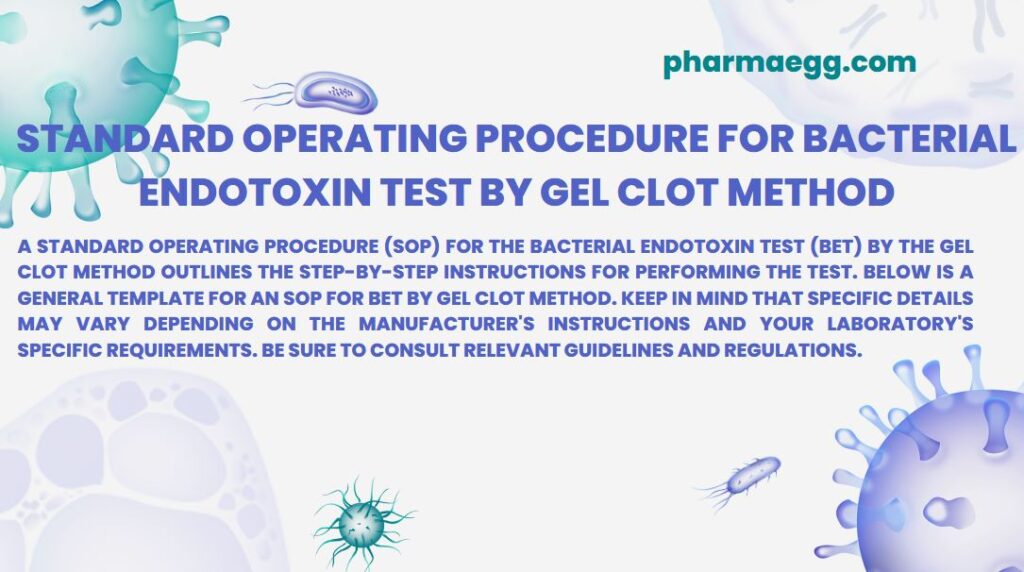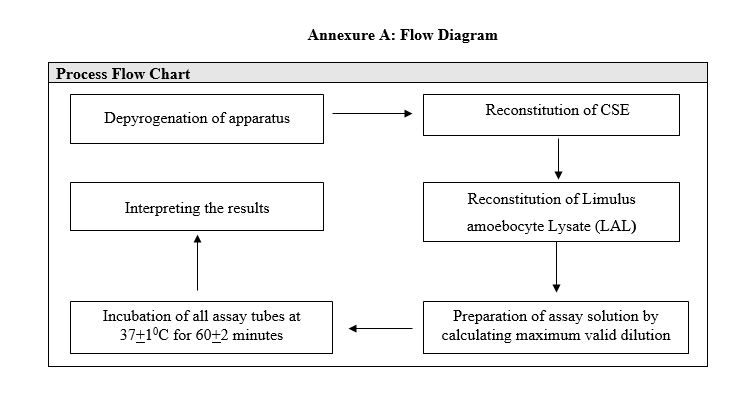
A Standard Operating Procedure (SOP) for the Bacterial Endotoxin Test (BET) by the Gel Clot Method outlines the step-by-step instructions for performing the test. Below is a general template for an SOP for BET by Gel Clot Method. Keep in mind that specific details may vary depending on the manufacturer’s instructions and your laboratory’s specific requirements. SOP for BET by Gel Clot Method Be sure to consult relevant guidelines and regulations.
PURPOSE
- This procedure has been established to provide the guidelines for LAL testing by Gel Clot Method in Microbiological lab to ensure the quality and purity of microbiological products.
- This provides a test for estimating a concentration of Bacterial Endotoxin that may be present in or on sample of the article to which the test is applied using Limulus Amoebocyte Lysate (LAL) obtained from horse shoe crab (Limulus poly phemus).
- The lysate extract from crab has ability to identify Bacterial Endotoxin. When endotoxin comes into contact with lysate in the lame test gel clot method, it forms a strong gel.
SCOPE
- This procedure is applicable to microbiological section of Quality Control Lab.
RESPONSIBILITIES & AUTHORITIES
- Microbiologist is responsible for proper LAL testing by Gel Clot Method.
- Quality Control Manager is responsible for implementation of this SOP.
REFERENCE & REQUIREMENTS
- European Pharmacopoeia 10.0
- Bacterial endotoxins 2.6.14
DEFINITIONS & ABBREVIATIONS
- Endotoxin: are relatively heat stable, lipopolysaccharide protein complexes contained in cell walls of many fermentative, grams negative bacteria such as E. coli and klebsiella pneumonia.
- Exotoxins: are heat labile protein complexes produced by certain gram-positive bacteria such as Staphylococcus aureus and Streptococcus Pyrogenes. Endotoxins and exotoxins become free during cell death and lysis.
- Gel Clot Technique: The lysate extract from crab has ability to identify Bacterial Endotoxin. In the endpoint gel clot method when endotoxin comes into contact with lysate, it forms a strong gel.
PROCEDURE
Material and Equipment’s
| Sr. | Instrument | Sr. | Instrument |
| 1. | Reaction Tubes | 2. | Incubator |
| 3. | Test Tube Rack | 4. | Pipettes |
| 5. | Non pyrogenic Test Tubes | 6. | Hot Air Oven with 250ºC |
| 7. | Non Pyrogenic plastic tips | 8. | Micro Pipettes |
| 9. | Control Standard Endotoxin (CSE), 0.5 μg /vial | 10. | LAL Reagent Water (LRW) |
| 11. | LAL multi test vial | 12. |
Safety Measures
- Avoid mouth pipetting
- After completing work wash the hands and face with antiseptic soap.
- Disposables should be tested for endotoxin contamination and interference (adsorption and/or extractable) with the LAL test.
- Wear protective gloves and mask.
- Don’t leave spatula with culture on the working bench without disinfecting it with IPA 70%.
Preparation of Apparatus
- All glass ware should be depyrogenated by exposing them at 250°C for 30 minutes in Hot Air Oven according to SOP.
Reconstitution of Reagents
SOP for BET by Gel Clot Method
Confirmation of Lysate Sensitivity
- Before using the lysate its sensitivity must be checked. The test should be carried out on a series of known standard endotoxin concentrations that bracket the label sensitivity to confirm the sensitivity of lysate (pyrotyl) (i.e. 2λ, 0.5λ and 0.25λ)(λ denotes the actual claimed sensitivity of lysate) if λ = 0.25 EU /ml and Endotoxin is 2500/vial then Endotoxin concentrations should be made as follows:
Control Standard Endotoxin (CSE)
- Control Standard Endotoxin (CSE) may be used to prepare controls for the Limulus Amoebocyte Lysate (LAL). The vials may appear empty, but on closer examination, a thin net of endotoxin may appear.
Reconstitute the CSE as follows:
- Remove the metal seal from the vial and aseptically remove the stopper.
- Add LRW to the vial. The recommended reorganization volume is 5 ml, however, an alternative volume can be used to achieve the desired concentration of the stock solution.
- To reconstitute with a pipette, break the vacuum by lifting the stopper just enough to allow air to enter, remove the stopper and add LRW.
- Seal the vial with Parafilm
- Vortex vigorously for one minute, at 5-10 minute intervals over a 30-60 minute period at room temperature.
- Store reconstituted CSE at 2-8°C for not more than four weeks.
- Do not freeze CSE.
- Vortex the CSE for at least 30 seconds immediately before making the first dilution. And make dilution as follows:
- Take 0.1ml from the stock CSE solution and add 0.9ml of LRW to obtain strength 50 EU/ml.
- Take 0.1ml from 1st dilution and add 0.9ml LRW to get 5EU/ml.
- Take 0.1ml from 2nd dilution and add 0.9ml LRW to obtain strength of 0.5EU/ml.
- Take 0.5ml of 3rd dilution and add 0.5ml LRW to get strength of 0.25EU/ml.
- Now if necessary take 0.5ml from 4th dilution and add 0.5ml LRW to obtain 0.125EU/ml
- Vortex between dilutions.
Reagent (Lysate)
- Gently tap the vial of LAL to cause loose LAL to fall to the bottom of the vial.
- Remove the crimp seal and break the vacuum by lifting the gray stopper.
- Do not contaminate the mouth of the vial.
- Do not inject through or reuse the stopper.
- A small amount of LAL left on the stopper will not affect the test.
- Reconstitute the LAL with 5ml LAL Reagent Water.
- The lyophilized LAL pellet will go into solution within few minutes.
- Before use, gently mix the contents of the vial to ensure homogeneity. Mixing too vigorously may cause excessive foaming which can cause a loss of sensitivity.
- Transfer 0.1ml of the reconstituted LAL into each depyrogenated glass test tubes placed in ice tray.
- Cover them immediately with aluminum foil and store these test tubes at or below -20 °C.
- Reconstituted LAL can be frozen once. Reconstituted LAL will retain activity for three months if frozen immediately after reconstitution and held at or below -20 °C.
Endotoxin Controls:
Positive Control
- The positive control concentration should be 2λ.
Positive Product Controls
- Are inhibition controls and consist of the specimen or dilution of specimen to which standard endotoxin is added. The final concentration of the added endotoxin in the test specimen should be 2 λ
Negative Controls
- LRW negative controls should be included with each batch of specimens tested.
Specimen Preparation
Dilute the sample to the required concentration which is established by calculating its MVD.
MVD = Endotoxin limit × Concentration of Sample
Lysate Sensitivity
Test Performance
- Add 0.1ml of each of negative control, test specimen, positive control and positive product control into separate test tubes already containing 0.1ml previously reconstituted and frozen LAL.
- Place the reaction tubes in an incubator at 37 + 1 ºC for 60 + 2 minutes. The reaction begins when sample is added into LAL but does not proceed at an optimum rate until the mixture reaches 37 ºC. If large number of specimens is tested in parallel, the tests should be batched and started at intervals that permit the reading of each within the time limit.
- Do not disturb the tubes during the incubation period. The gel forming reaction is delicate and may be irreversibly terminated if the tubes are handled, agitated or vibrated.
- Remove and read reaction tubes one at a time. Do not wipe the tubes dry or bump them against the side of the rack during removal. Invert the tube in one smooth motion at an angle of 180º; do not pause half way in the inversion unless it is obvious that the gel has not formed.
- A positive test is indicated by the formation of a gel which does not collapse when the tube is inverted
REQUIRED DOCUMENTS:
- Flow Diagram (Annexure A)
- Sterility and LAL Test Log
- LAL Test (Gel Clot Limit Method) Record(S-QC-F-MI-00.00)


